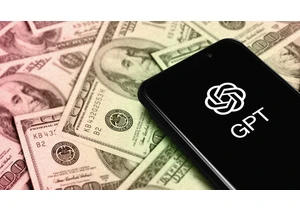This story originally appeared in The Technology Letter and is republished here with permission.
Thursday evening’s earnings headlines contained a giant curve ball: Alphabet’s Google announced its first-ever quarterly dividend, twenty cents a share, and also added to its share buyback program another seventy billion dollars.
Before you get too excited, note that the dividend yield of an 80 cents a year, given Alphabet’s stock price at $174 after-hours, is a yield of barely one half of a percent. That makes it one of the lowest payouts of large tech firms, putting it below Microsoft’s three quarters of a percent, Apple’s half a percent, and chip giant Intel’s one percent.
Nevertheless, lots of income investors will have to own Google now, so Alphabet shares rose twelve percent after-hours on Thursday.
The announcement obscured what had been the main event expected by investors: The cloud and artificial intelligence battle between Google and Microsoft, which also reported.
The upshot of that shoot-out was that both companies comported themselves well, but Microsoft won by a nose for being more specific with its disclosure.
Microsoft’s Azure cloud revenue growth sped up from twenty-eight percent growth the prior two quarters to thirty-one percent. Microsoft said seven points of that was from AI-related stuff, the various “Copilots” it has been adding.
It was a “get out the popcorn moment” for Microsoft, writes Dan Ives of Wedbush Securities, a bull on the stock. Microsoft, he writes, “continues to put together masterpiece after masterpiece as this quarter represents its dominant position in the AI Revolution.”
Alphabet’s cloud revenue growth of twenty-eight percent was also stronger than the Street was expecting. But Google is not as specific as Microsoft in talking about how much it might be making off of AI.
The company’s CFO, Ruth Porat, simply said that cloud saw “an increasing contribution from AI” without breaking out numbers. CEO Sundar Pichai said the company has “clear paths to AI monetization through ads and cloud, as well as subscriptions,” without going into detail. He did note that the company has over a hundred million subscribers to its “Google One” subscription offering, which includes access to its “Gemini” AI program.
Some bulls think Google’s healthy results are a vindication. After all, a year ago, many were predicting Google would be decimated by Microsoft’s AI dominance. Mark Schmulik of Bernstein writes, “We may well be on the other side of doomsday AI search share loss fears with Search growth accelerating to fourteen percent [growth].” That shows, he writes, that “folks using Google’s GenAI search (SGE) search more!”
Both Microsoft and Google indicated they will continue to spend like crazy on AI, with Porat noting that Google will moderate other expenses “in order to create capacity for the increases in depreciation and expenses associated with the higher levels of investment in our technical infrastructure.”
Everything is being sacrificed for AI, in other words.
Really, the event of the evening was the Google dividend, which was a surprise. A year ago, when Porat was asked about the prospect of a payout, she remarked there was no plan to do so, saying share buybacks were “the best approach for us because it provides flexibility, which is valuable given we operate in such a dynamic and competitive area.”
Tonight, Porat told analysts, “We view the introduction of the dividend as further strengthening our overall capital return program.” As for Google’s buyback plan, it is the same as a $70 billion authorization announced a year ago. It remains to be seen how much of it will actually be spent. Last year, Google purchased $62 billion worth. The amount has been steadily increasing since the company began buying back shares in 2017.
The dividend is payable June 17th to holders of record as of June 10th.
Notably, Porat didn’t say anything about a replacement for herself since she announced in July of last year that she would transition to being chief investment officer.
Intel continues to limp along
Elsewhere on Thursday, chip giant Intel reported results, the first update since it formally restructured its income statement earlier this month to report its chip factories with their own profit and loss statement. The company’s results and outlook both came in below expectations, sending the stock down eight percent in late trading. Analyst Lou Miscioscia of Daiwa Capital Markets writes that the continued weakness is more of the same from Intel. “For Intel over the past 5 years it has continuously seen [sic] like two steps forward and one back,” he writes. “A weak start 2024 is not helping the challenges they face in the market and with IFS [Intel Foundry Services, the company’s bid to be a contract chip maker for other chip companies.]” Likewise, Cantor Fitzgerald’s CJ Muse writes that there was “Overall, nothing terribly shocking within the call as Intel remains very much a show-me story with meaningful challenges still ahead.”
I’ve been saying for a while now that Intel’s got a tough hill to climb, and that it may continue to “limp along” in its path back to semiconductor manufacturing leadership. Tonight was, well, more limping. As I said in February, its cheaply valued stock is “an option on many things going right at Intel that currently seem like long shots.” With the after-hours decline, Intel stock is now down thirty-six percent since the start of the year.
BE Semiconductor needs a little more time
A recent addition to the TL20 group of stocks worth considering is BE Semiconductor of the Netherlands, the maker of chip equipment for what’s called “hybrid bonding,” the process of gluing together multiple chips so that they function as one. That is very important to make increasingly large artificial intelligence chips. (See the March report on memory technologies.) That opportunity remains in the future, as Thursday morning’s forecast from the company fell short of expectations, the second time in a row BE’s quarterly sales outlook has fallen short. The company is coming out of eight quarters of a market correction in packaging, a lot of that linked to the struggling mobile market, and it’s still a drag.
On Thursday morning’s call, CEO Richard Blickman told analysts the recovery “is progressing more slowly than previously anticipated due to continued excess capacity conditions in a number of our end user markets.” Blickman, however, told analysts the company’s prospects for AI-related sales of technology “continue to be favorable.” He said BE is increasing its R&D spending for those AI-related areas “to take advantage of growth anticipated in the period 2024, 2025, 2027.” The bulls on the stock are unfazed.
Pierre Ferragu of New Street Research, a bull on the stock, writes that his “thesis is still intact,” despite recovery being pushed to the latter part of this year. BE’s market is “in the early stages of a recovery,” writes Ferragu, and “Hybrid bonding is taking off, with visibility on broad adoption in Smartphones, CPUs, GPUs, and HBM in coming years.”
I’m in Ferragu’s camp: an opportunity that could be many years for BE will tend to run into snags now and then, but nothing suggests the company’s technology isn’t key to a lot of AI chip development. It’s a matter of time. BE stock is down one percent this year.
This story originally appeared in The Technology Letter and is republished here with permission.
Connectez-vous pour ajouter un commentaire
Autres messages de ce groupe

The role of the CFO is evolving—and fast. In today’s volatile business environment, finance leaders are navigating everything from unpredictable tariffs to tightening regulations and rising geopol

In June, Google released its newest smartphone operating system, Android 16. The same month, Apple previewed its next smartphone oper


I’ve worked at the bleeding edge of robotics innovation in the United States for almost my entire professional life. Never before have I seen another country advance so quickly.
In


Restaurant industry leaders are excited for

Elon Musk’s anger over the One Big Beautiful Bill Act was evident this week a
